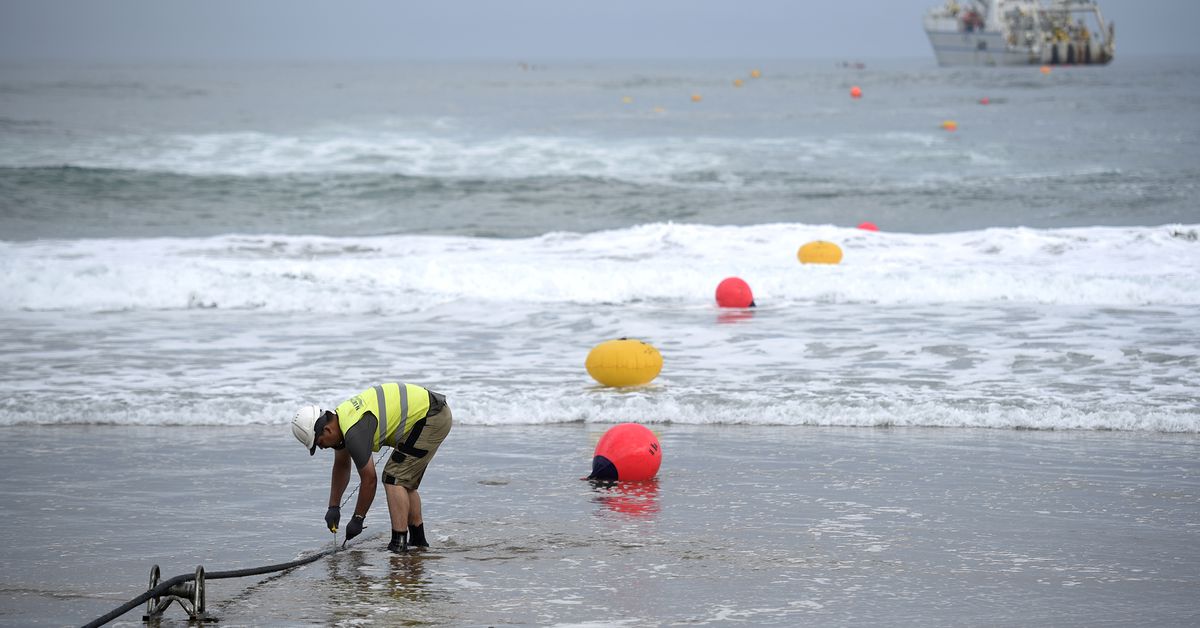
The web of undersea cables that transmit data around the world could one day be used to track earthquakes and tsunamis, according to new research. During a test run last year, one of Google’s fiber-optic cables was able to successfully pick up on nearby earthquakes by detecting distortions in light pulses sent along the cable. It’s a new approach to an idea that researchers have been working on for the past several years.
“Can we find a less expensive way to cover the ocean with geophysical sensors? There’s already this telecommunication cable infrastructure out there. If you can turn them into sensors, that’s wonderful — and that’s what we’re doing now,” says Zhongwen Zhan, an assistant professor of geophysics at the California Institute of Technology and lead author of the research published today in the journal Science.
On top of their main job of sending data all over the world, these cables could one day send early warnings to people on shore when a tsunami is barreling their way. They could also give seismologists and geophysicists a closer look at earthquakes that occur underwater. Since nearly all the sensors currently used to detect earthquakes are on land, these cables could fill in huge gaps in scientists’ ability to observe seismic activity. The novel approach doesn’t even require installing any new equipment to the existing web of more than a million kilometers of fiber optic cables that cut across the seafloor.
The new approach capitalizes on what the cables are already designed to do. When a transmitter at one end of the cable sends out a light signal transmitting data, light waves are oriented in a particular direction. If an earthquake hits, it might shake, bend, or twist the cable — and that changes the orientation of the light waves. At the other end of the cable, Google notices distortions and corrects them. Now, it wants to share its data, changes to what’s called the “state of polarization” of light, with seismologists like Zhan so they can study the earthquakes that caused the distortions.
Between December 2019 and September 2020, Zhan’s research team documented roughly 20 moderate to large earthquakes using Google’s 10,500-kilometer-long cable, Curie, which runs from Los Angeles, California to Valparaíso, Chile. The cable was also able to pick up swells in the ocean caused by storms. That suggests the technique can also be used to spot tsunamis, which earthquakes can trigger.
The ability to see tsunamis while they’re still far from shore could save lives. Beyond having a better view of the ocean than the small number of existing sensors specifically designed to look for tsunamis, fiber optic cables can also send warnings to shore much faster — perhaps in a matter of milliseconds, according to Google.
“We’re humbled and excited by the possibility of collaborating with the optical, subsea and seismic research communities to use all of our cable infrastructure for greater societal benefits,” Google wrote in a blog last July, shortly after the company had reached out to Zhan to further develop the new approach to seismic sensing on the seafloor.
“We hope this new approach can really give people a better chance of catching those events early on, so that people have more time to react,” Zhan says.
In 2018, similar research was published that showed that seafloor cables had the potential to detect earthquakes and tsunamis — but that approach came with some limitations. Cables needed to be fitted with specialized equipment to shoot lasers down the cable. In comparison, this new approach saves money because it doesn’t require any new infrastructure. There were also concerns that adding equipment to the cables could open the door to security breaches, allowing bad actors to access data sent across the network. Zhan says that’s not an issue with the new approach; scientists can’t see information about the transmitted content when studying the polarization of light.
“It’s a perfectly safe way of leveraging pre-existing infrastructures to do something that is good for the society and science,” Zhan says.
Article From & Read More ( How one of Google’s massive undersea cables detects earthquakes - The Verge )https://ift.tt/3bUkzcn
Science
No comments:
Post a Comment